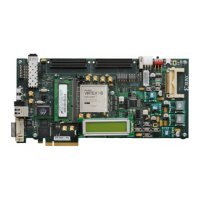226 www.xilinx.com Virtex-6 FPGA GTX Transceivers User Guide
UG366 (v2.5) January 17, 2011
Chapter 4: Receiver
RX Loss-of-Sync State Machine
Functional Description
Several 8B/10B protocols make use of a standard Loss-of-Sync (LOS) state machine to
detect when the channel is malfunctioning. Each GTX receiver includes a LOS state
machine that can be activated for protocols requiring it. When the state machine is not
used, the LOS state machine's ports can be re-used to monitor the condition of incoming
data.
Figure 4-28 shows the standard LOS state machine, used in several 8B/10B protocols (for
example, XAUI) to detect problems in the incoming data stream.
To activate the LOS state machine in the GTX transceiver, RX_LOSS_OF_SYNC_FSM is set
to TRUE. While the state machine is active, the RXLOSSOFSYNC port presents its current
state.
If the LOS state machine is inactive (RX_LOSS_OF_SYNC_FSM = FALSE), the
RXLOSSOFSYNC port presents information about the received data. The
RXLOSSOFSYNC entry in Table 4-36 shows the meaning of the RXLOSSOFSYNC port in
this case.
The operation of the LOS state machine can be tuned using the RX_LOS_INVALID_INCR
and RX_LOS_THRESHOLD attributes. RX_LOS_THRESHOLD adjusts how sensitive the
LOS state machine is to bad characters (RX_LOS_THRESHOLD divided by
RX_LOS_INVALID_INCR) to change the machine from the SYNC_ACQUIRED state to the
X-Ref Target - Figure 4-28
Figure 4-28: LOS State Machine
00
01 10
No Comma Received
Count = RX_LOS_THRESHOLD
Count < RX_LOS_THRESHOLD/RX_LOS_INVALID_INCR
Channel Alignment
or
Comma Realignment
Invalid Data
Comma Received
UG366_c4_25_102910
Valid Data + 4 RXRECCLK Cycles
Valid Data + < 4 RXRECCLK Cycles
SYNC_ACQUIRED
RESYNC LOSS_OF_SYNC

